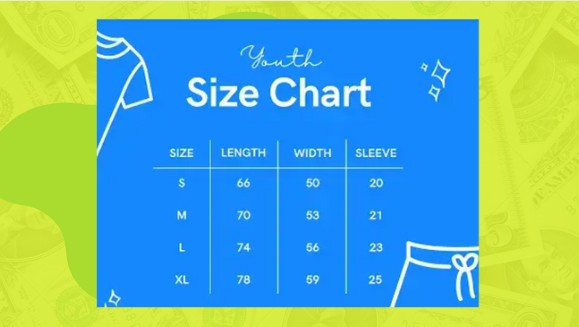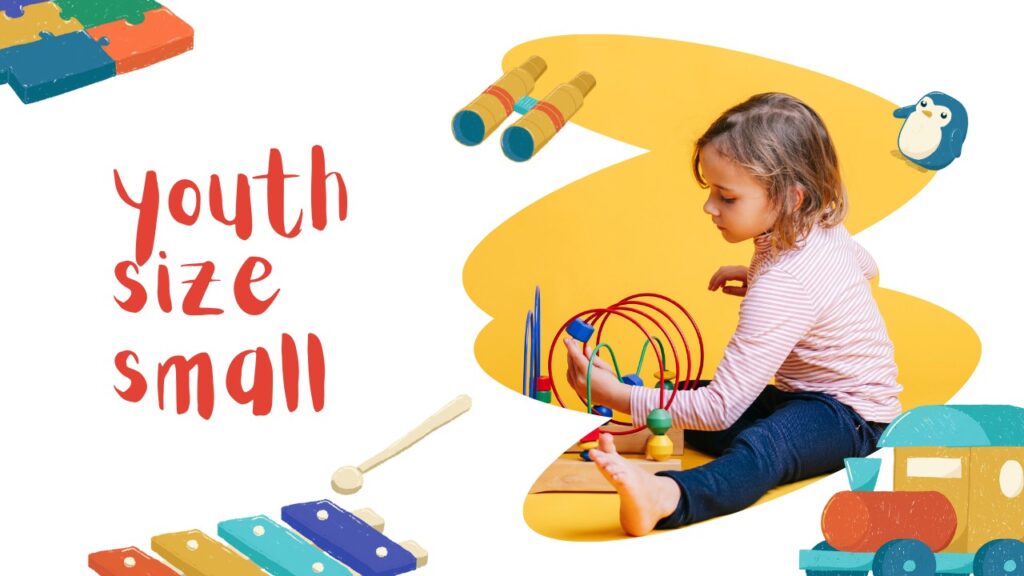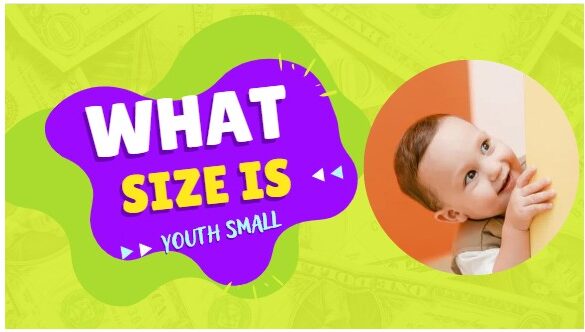What Size is Youth Small? Mastering Youth Clothing Sizes
The world of children’s fashion is like a thrilling rollercoaster ride. We often get asked what size is youth small. Parents often find themselves lost in the labyrinth of sizes, styles, and brands with kids sprouting up faster than a beanstalk.
They’re on a quest to ensure their little fashionistas are both comfy and runway-ready. On the flip side, retailers are navigating a challenging maze, trying to meet the diverse demands of their pint-sized clientele while keeping their competitive edge sharp.
So, we’re diving deep into the realm of youth clothing sizes. We’ll give parents the inside scoop to help them make savvy choices for their growing offspring, and we’ll let retailers in on the secrets of offering youth sizes without breaking the bank.
Contents
- 1 Average Youth Small Sizes
- 2 What Size is Youth Size Small Shirt and Pants
- 3 The Average Age for a Youth Size Small
- 4 Pro Tips for Parents When Shopping for Youth Clothing
- 5 Typical Clothing Sizes for a Youth Size Small
- 6 Pros and Cons of Carrying Youth Size Small for Retailers
- 7 Mastering Youth Clothing Trends: A Fashionable Journey
- 8 Online Shopping and Inclusivity Matters
- 9 Fashion Icons for Kids
- 10 Navigating Youth Fashion for Retailers
- 11 Conclusion
Average Youth Small Sizes
“Hey, what size is youth small?” That’s a question that dances on the minds of parents and kids alike as they embark on their shopping adventures. To demystify this puzzle, let’s start by dissecting what youth size small means, and then we’ll explore all the nooks and crannies of this tiny universe.
Youth Small Age
A youth size small is the Holy Grail for kiddos aged approximately 4 to 6. These threads are custom-made for comfort and style, allowing the little ones to bust a move and play like champs.
Average Youth Small in Toddlers
In the grand scheme of things, a youth small usually lines up with clothing sizes 2-4. These sizes are like Cinderella’s glass slipper for the younger crowd—tailored to perfection. Picking a youth small guarantees clothing that’s as comfy as a marshmallow mattress.
What Size is Youth Size Small Shirt and Pants

Understanding the nuts and bolts of a youth size small is crucial to avoid fashion fiascos. A standard youth small typically rocks the following stats:
- Chest: Approximately 27 inches
- Waist: About 25 inches
- Hip: Approximately 28 inches
These numbers are your guiding stars when selecting clothing for a youth-size small. Well-fitted threads are the name of the game. Here are some pro tips for nailing the perfect fit:
- When it comes to pants, think about the waist measurement. Youth pants usually have an inseam of about 28 inches.
- Shirts? Choose a size that mirrors your child’s chest measurement.
- Jackets or coats? It’s a double whammy—consider both the chest measurement and how long you want the coat to be.
- For dresses or skirts, go for a size that matches your kiddo’s waist measurement.
The Average Age for a Youth Size Small
The average age for a child rocking a youth size small is typically in the range of 4-6 years old. But remember, kids don’t follow a one-size-fits-all rule. They’re like snowflakes, each one unique. So, parents, keep your eagle eyes on your little sprout’s individual size and growth rate.
Pro Tips for Parents When Shopping for Youth Clothing
Navigating the treacherous waters of children’s fashion is a wild ride. To make your life easier, here are some nuggets of wisdom:
- Consider Proportions: Kiddos grow like weeds, so don’t expect them to fit into adult sizes. Keep their unique proportions in mind.
- Shop Wisely: Kids don’t come with a pause button. They grow at different rates, so go easy on the wallet and buy a few pieces at a time. Replace them as your kiddo goes through growth spurts.
- Explore Specialized Brands: Seek out brands that specialize in children’s clothing—they’re like the Harry Potters of the fashion world. They’re likely to offer comfy, accurate fits for those little bodies.
Typical Clothing Sizes for a Youth Size Small
A youth size small is usually a snug fit in the clothing sizes 4-6 category. For girls, this could mean rocking a size small shirt, slipping into size 4 pants, and kicking it in size 6 shoes. Boys, on the other hand, might swagger in a size small shirt, slide into size 6 pants, and conquer the world in size 8 shoes.
But, beware! Sizing isn’t a one-size-fits-all game. Brands can be as unpredictable as a box of chocolates. So, when in doubt, consult the size chart of the specific brand you’re eyeing. If you want to know about Youth Size medium then read it here.
Pricing Insights for a Youth Size Small
The price tags on youth-size small clothing are a lot like the stock market—sometimes they skyrocket, and other times they dip. Prices can range from pocket change at $15 to splurging territory well over $100. What you fork out depends on the brand and the quality of the garment.
Here are some factors to keep in mind:
- Occasion: Think about where your little fashionista will be strutting their stuff. Special occasions might justify a splurge, but everyday wear can be budget-friendly.
- Material Matters: Cotton is like a trusty pair of sneakers—versatile and comfy. But for those red carpet moments, consider fancier fabrics that’ll make your kiddo feel like royalty.
- Style Statement: There are more shirt styles out there than emojis. Pick one that matches your child’s personality and the occasion.
- Durability: High-quality clothing is like a marathon runner—it lasts longer and survives the rigors of active kids.
- Care Matters: Follow the care instructions on the label to keep your precious garments looking fresh and fabulous.
Pros and Cons of Carrying Youth Size Small for Retailers
For retailers, the decision to dive into the youth-size small pool and cater to the mini-fashionistas isn’t all rainbows and unicorns. Let’s break down the ups and downs of offering youth sizes:
Pros:
- Convenience for Parents: Stocking a range of youth sizes, including youth small, is like offering a golden ticket for parents. They can find everything in one spot, hassle-free.
- Attracting Customers: Diversifying your inventory with youth sizes is like opening a treasure chest of opportunities. You might lure in customers who wouldn’t have given your store a second glance.
- Cha-ching! Sales Boost: Youth sizes are like hotcakes—everyone wants a piece. They can boost your sales, especially during back-to-school and holiday shopping sprees.
Cons:
- Big Bills: Expanding your inventory to include youth sizes, like youth small, can be like going on a shopping spree. It costs more, plain and simple.
- Fit Fiascos: Kids come in all shapes and sizes, and their proportions can be as unpredictable as the weather. Finding the perfect fit for every child can be as elusive as a pot of gold at the end of a rainbow.
- Rapid Growth Pains: Kids outgrow youth sizes faster than you can say “growth spurt.” This can slow down your sales turnover and leave you with the constant headache of updating your inventory.
Understanding youth clothing sizes is like having a secret map for parents and retailers. Parents can make savvy choices by getting the lowdown on sizing standards and considering factors like fit, comfort, and the occasion.
Retailers can cater to their customer’s needs by offering a smorgasbord of sizes and weighing the pros and cons of adding youth sizes to their repertoire. Navigating the wild world of children’s clothing sizes might seem like finding a needle in a haystack.

But with a little knowledge, parents and retailers alike can ensure that kids are not just comfortable but also rock their style, no matter how quickly they sprout and change. So, let your mini-fashionistas shine, and remember that understanding youth clothing sizes is the key to unlocking their wardrobe potential.
Mastering Youth Clothing Trends: A Fashionable Journey
Now that we’ve mastered the art of sizing, let’s dive deeper into the ever-evolving world of youth clothing trends. Kids these days aren’t just about comfort; they want to make a style statement too. You can also learn about Youth Size Large here.
The Influence of Pop Culture
Kids these days are like sponges, soaking up pop culture influences faster than you can say “rock ‘n’ roll.” From music to movies, their style choices often mirror their favorite celebs and fictional characters.
So, it’s no surprise that kids are all about those Harry Potter robes, superhero costumes, or Disney-themed outfits. Parents, be prepared for your little ones to demand attire inspired by their idols.
Eco-Friendly Fashion
The younger generation is all about saving the planet, and that extends to their fashion choices. Sustainable and eco-friendly clothing is gaining popularity among kids and their parents.
Brands that use organic materials, recycled fabrics, and ethical manufacturing processes are a hit. It’s not just about looking good; it’s about feeling good about the planet too.
Streetwear and Athleisure
Kids these days are blending comfort and style like never before. Streetwear, with its cool and casual vibe, is a massive trend. Hoodies, sneakers, and graphic tees are all the rage. Athleisure, a fusion of athletic and leisure wear, is also a hit.
Yoga pants, joggers, and sports-inspired clothing are staples in many kids’ wardrobes.
Colorful Expressions and DIY Fashion
Youth fashion is all about embracing vibrant colors and patterns. Neon shades, tie-dye, and bold prints are a go-to choice for many. Kids want to stand out, and their clothing reflects their desire for self-expression.
Customization is king in the world of youth fashion. Kids love to personalize their clothing with patches, embroidery, and DIY designs. It’s a way for them to show off their creativity and individuality. If you don’t know about Youth Size XS then explore this post to gain more knowledge.
Online Shopping and Inclusivity Matters
The digital age has transformed the way kids shop for clothing. Online shopping is not just convenient; it’s an experience. Many brands have interactive websites that engage kids, making the process more fun. Virtual try-ons and AI-powered style recommendations are becoming the norm.
The fashion industry is slowly but surely becoming more inclusive. Brands are expanding their size ranges to accommodate all body types. Adaptive clothing for kids with disabilities is also gaining traction, ensuring that every child can express themselves through fashion.
Fashion Icons for Kids
Just like adults have their fashion icons, kids have their own set of style influencers. Whether it’s a teen sensation from TikTok or a young actor from a popular TV show, these individuals have a significant impact on youth fashion trends. Parents, be prepared to hear about these idols regularly.
For kids, fashion isn’t just about looking good; it’s about feeling confident. When they put on an outfit they love, it’s like a superhero donning a cape. It gives them a boost of self-assurance, and that’s priceless.
For retailers looking to cater to the youth fashion market, it’s not just about the sizes; it’s about staying in tune with the latest trends. Here are some tips:
- Stay Current: Youth fashion trends change rapidly. Keep a close eye on what’s hot and what’s not. Follow youth fashion influencers on social media to stay in the loop.
- Sustainability Sells: Consider stocking sustainable and eco-friendly clothing. It not only appeals to environmentally conscious parents but also to kids who want to make a positive impact.
- Interactive Shopping: Create an engaging online shopping experience. Virtual try-ons, fun quizzes, and interactive features can make the process exciting for kids.
- Inclusivity Matters: Ensure your size range is inclusive. Kids come in all shapes and sizes, and they should find something that fits their style.
- Collaborate: Partner with popular youth brands or influencers for collaborations. It can boost your brand’s credibility and appeal to a broader audience.
- Quality Matters: Kids can be rough on clothing. Stock durable, high-quality items that can withstand the wear and tear of active youngsters.
- Customer Feedback: Listen to your young customers. They often have valuable insights and can help you understand what’s trending in their world.
Conclusion
Now you know what size is a youth small. Mastering youth clothing sizes is just the beginning. To truly succeed in the world of children’s fashion, understanding the ever-changing trends and preferences of young consumers is vital.
Kids today aren’t just looking for clothes; they’re seeking a means of self-expression and confidence. Parents and retailers who can navigate this dynamic landscape will not only keep kids looking stylish but also empower them to embrace their unique personalities through fashion.
So, whether it’s sizing or style, remember that the world of youth fashion is an exciting journey filled with endless possibilities.

